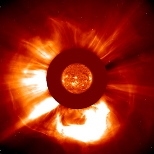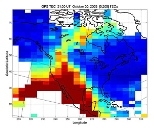In late October, scientists at MIT's Haystack Observatory watched as a surprisingly violent solar flare lashed out from the sun and sent an intense burst of energy and matter racing into space. When this electrically charged stream of plasma collided with Earth's magnetic field, it spurred a series of dramatic changes in the ionosphere (upper atmosphere).
"These powerful storms were the biggest in the past decade," said John Foster, associate director and leader of the Haystack Atmospheric Sciences Group, which is responsible for tracking changes during such bouts of unsettled space weather. "The effects we observed, such as the redistribution of the ionosphere, were the most pronounced of any we've seen."
The Oct. 28 solar flare was among the most powerful ever measured; astronomers classified it as an X17.2 flare (on a scale of X-ray intensity ranging from 1 to 20). The associated coronal mass ejection unleashed a flood of charged particles directly toward Earth and triggered auroral displays seen as far south as Texas. During the next few days, two more giant eruptions sent their energy hurtling our way. By late November, the sunspot group responsible for October's flares was facing earthward again, ready to unleash more violent activity.
During the storms, the Haystack team reported strong disturbances in the ionosphere over the continental United States, accompanied by a plume of plasmaspheric material (electrically charged particles) streaming toward the north polar regions. The ionospheric redistributions observed in October and November gave Haystack observers plenty of data to analyze over the coming months, and more information to integrate into what's already known about space weather and the complex electrical coupling between the sun and Earth.
For the space-weather trackers at Haystack, such outbursts are the perfect storms: strong, fast-moving solar winds and streams of plasma interacting with Earth's magnetic field, creating disturbances and circulating electrical currents in the upper atmosphere. Disturbances induced by space weather have been a research focus of the Haystack group for more than 30 years. While satellite operators, pipeline companies and power grid owners rush to safeguard their equipment, Haystack space-weather watchers swing into action, using the Westford-based Millstone Hill Radar (supported by the National Science Foundation), a Global Positioning Satellite receiver tied into a worldwide network of more than 900 GPS sites and a set of optical instruments.
Geomagnetic storms are powerful evidence of the electrical ties coupling Earth and the sun, particularly when they stir up activity in the near-Earth environment. According to Foster, the changes the Haystack group observes are dramatic and rapid.
"During heavy bouts of space weather triggered by solar flares, material in the upper ionosphere is redistributed from Earth's lower latitudes to the mid-latitudes and ultimately up to the rarefied atmosphere over the polar regions," Foster said. "This happens very quickly, with charged plasmas in the ionosphere moving at speeds of a kilometer per second. This material moves from the equatorial regions and South America up to the north slope of Alaska on about a 30-minute time scale."
One effect that intrigues Foster's team is an apparent preferential perturbation in the ionosphere over the North American continent during geomagnetic storms. "This is an effect that is not well understood," he said. "It's an area where we're doing groundbreaking research to figure out why this sort of asymmetry exists."
A version of this article appeared in MIT Tech Talk on December 3, 2003.







